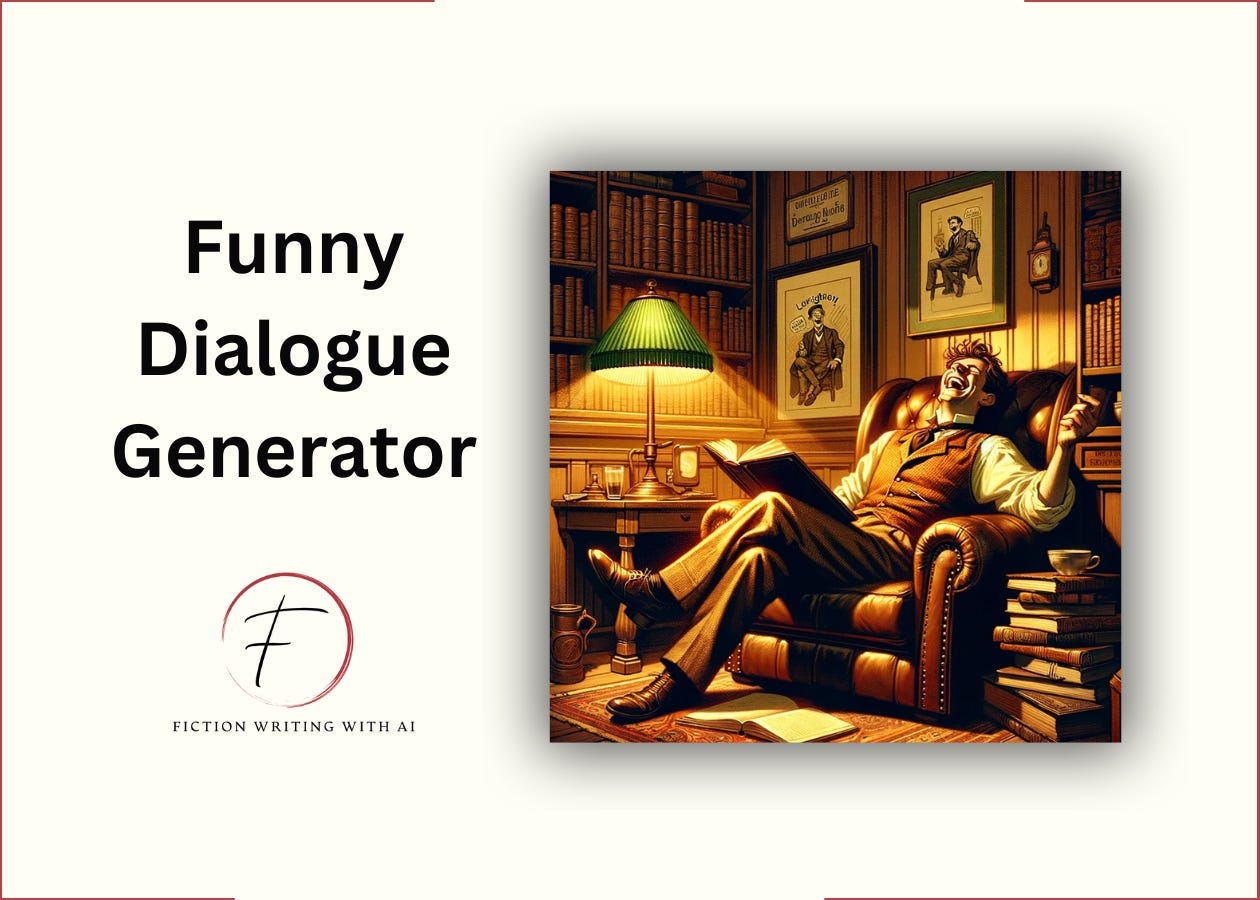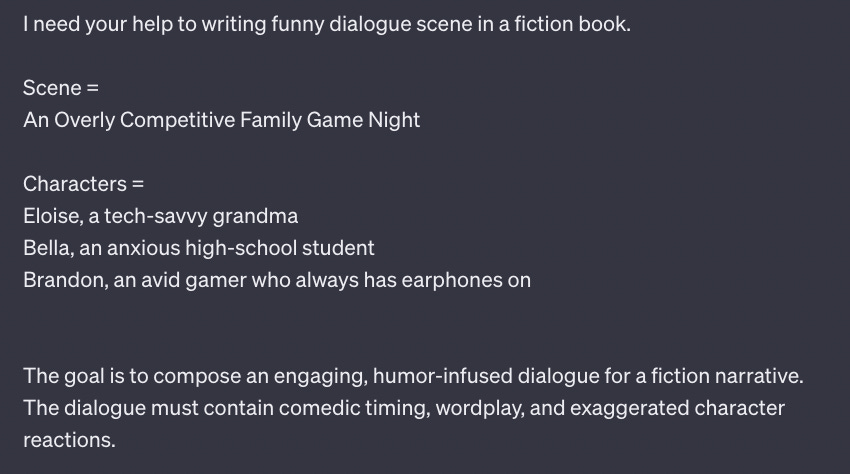Hey there!
Humor is one of the most powerful tools in a writer's arsenal.
Funny dialogue makes your characters more relatable, your story more engaging, and your readers more invested in the world you've created. And nothing says “cutting-edge humor” like a machine that thinks binary code is a hoot. Which is why today we are going to help you write funny dialogue with AI.
In this post you’ll learn how to:
Subvert your reader’s expectations with delightful surprises
Get your characters cracking jokes that you wish you’d thought of first
Sprinkle in some funny sounding words that’ll even make your grumpy grandpa giggle
And so much more!
Let's goooo!
7 Tips To Write Hilarious Dialogue Guaranteed To Make Your Readers Smile
Good comedy doesn’t come naturally to everyone.
Fortunately, it can be learned with a little practice (and some savvy AI prompting).
Here are 7 comedy writing tips to lighten up the mood in any fiction dialogue:
1. Make Your Character Talk Funny
Your character’s voice is the source of their comedic charm..
They become memorable through their distinctive quirks and idiosyncrasies. Think Elle Woods in "Legally Blonde" with her fabulous oblivion, or Jack Sparrow's flamboyant swagger, or Sheldon Cooper's literal interpretations. Each of their personalities, background, vocabulary, and quirks all come to life when they talk.
Here are 3 ways you can pull on you character’s voice:
Signature phrases. Does one character overuse words like "rubbish", "poppycock" or "balderdash?” Does another character sprinkle Spanish words into their speech? Do they repeatedly get common idioms hilariously wrong?
Extreme accents. A Southern drawl, a Scottish brogue , or a Long Island lockjaw are all funny.
Clashing voices. Put a prim and proper elderly lady next to a crass, foul-mouthed rebel. Or have a cynical pessimist play against an over-enthusiastic optimist. When two distinct voices collide, the comedy comes from the juxtaposition.
The key is giving each character a voice so unique that you can tell who is speaking simply from the dialogue, without any tags. This not only makes it easier to follow conversations, but also helps ratchet up the humor potential.
2. Use Clever Wordplay
Sprinkle in puns, double entendres, oxymorons, and irony to make readers chuckle (and groan).
Take a familiar cliché or saying and twist it in an unexpected way.
"The early bird gets the bagel"
"Curiosity killed the cat, but satisfaction brought it back"
"People who live in glass houses shouldn't throw stones, they should install curtains"
Give literal or absurd interpretations to idiomatic phrases:
"My funny bone has a fracture"
"I'm so hungry I could eat a horse, but I shouldn't because that would be unethical"
"It's raining cats and dogs, so I'd better bring my umbrella to avoid wet animals on my head"
Mash up contradictory metaphors creates silly incongruities:
"It's not rocket surgery"
"We'll burn that bridge when we get to it"
"This isn't my first rodeo at the batting cage"
The juxtaposition of clashing figurative language tickles the brain. Just be sure the wordplay arises naturally from your characters rather than feeling too forced or convoluted.
3. Exaggerate
Take your characters' reactions, emotions, or descriptions and blow them out of proportion.
Leaning into hyper-extreme descriptions, reactions, and analogies rings humor from taking things to the maximum level. It allows characters to let off steam by bending reality. Readers laugh both at the exaggerated thing itself and the fact that the character is overreacting to it.
For example:
"Your driving is worse than a blind sloth on steroids."
"This day has been a never-ending marathon of misery."
"I will unleash a typhoon of fury if you eat my last cookie."
"She ate faster than a wrecking ball swinging through a buffet."
"His stomach growled louder than a blue whale amplified through arena speakers."
Exaggeration reveals your characters' amusing mindset.
Don't be afraid to push your analogies into absurdly funny territory. The more you can compare unlike things and take the comparison to ridiculous extremes, the more you can mine humor from the absurd imagery.
4. Leverage Comedic Rhythm
Don't rush into the next line.
Build up slowly to the comedic moment. Draw readers in gradually, then hit them with laugh when they least expect it. Punctuate jokes by inserting an ellipsis “…” or em dash “—” at just the right moment to highlight the comedic turn. Play around with accelerating and decelerating the speed of the conversation. Two characters going from bickering at a rapid fire pace to one character suddenly speaking verrrry slowwwly can be amusing.
Comedy is about rhythm, pace, and timing.
Give readers a beat to chuckle before moving forward.
5. Set Up Funny Misunderstandings
One technique that generates automatic laughs is crafting moments when characters completely misinterpret each other.
Moments of misunderstanding work well in comedy because it builds an awkward situation ripe for laughs, especially if you escalate the misunderstanding. They allow you to reveal quirks about a character's personality as they fumble to respond. You can mine a ton of comedy from misunderstandings by heightening the absurdity of the situation and the character's reactions.
You can engineer these misunderstandings in all kinds of amusing ways:
Have characters literally answer a different question than what was asked. Character 1: “Do you want to get dinner tonight?” Character 2: “Yes I changed the locks.”
You can play with mistaken identity. Character A thinks they are talking to Character B but it's actually Character C.
Build humor through characters jumping to incorrect conclusions about each other's words or actions. For example if Character A does something innocuous but Character B reads it as suspicious. Or where Character A takes something very literally when Character B means it figuratively.
6. Employ Running Gags
Inside jokes and running bits are a hallmark of funny dialogue.
Create an ongoing gag by having your characters reuse a funny line or joke in different situations throughout the story. The familiarity and variation on a theme will delight readers.
What does Homer Simpson always say?
“D’oh!”
Running gags work because of the recognition factor. Readers chuckle because they remember the original joke and enjoy seeing it reused in a new context. Just take care that the bit doesn't get overused to the point of becoming annoying.
7. Weave In Funny Dialogue Tags
Your dialogue tags (the words that attribute which character is speaking) can add an extra punch of humor or convey the tone.
Funny dialogue tags add color and convey the emotion behind the lines. They are subtler than modifying the actual dialogue, so they don't distract from the jokes.
For example:
"Well that was a free waste of time," Samantha muttered under her breath.
"We're lost in the middle of a jungle with no cell service," Mark replied, hands flapping with panic.
"I think the ferret went down my pants," said Uncle Steve nonchalantly while scanning the floor.
Some tips for funny dialogue tags:
Tag dialogue to show the tone or mood: whispered, hissed, sang
Use unexpected adverbs and verbs for actions: quipped, deadpanned, blurted
Attach funny descriptors or titles for who is speaking: replied the lanky wizard with an eye-roll.
Avoid relying solely on "said" and get creative with tags that enhance the comedy.
Now let’s put everything together into an entertaining scene and get AI to help.
Generate Humorous Dialogue With AI
This prompt is designed to write a funny dialogue between a cast of characters.
You supply the scene and the people in the scene and AI will take care of the rest. Keep in mind, the more context (sub-genre, setting, plot points, etc) you provide, the better the outcome. But if all you need are a few ideas, then a single sentence short scene and character description will do the trick.
AI is amazing at filling in the details for you.
Here’s the prompt:
Keep reading with a 7-day free trial
Subscribe to Fiction Writing With AI to keep reading this post and get 7 days of free access to the full post archives.







